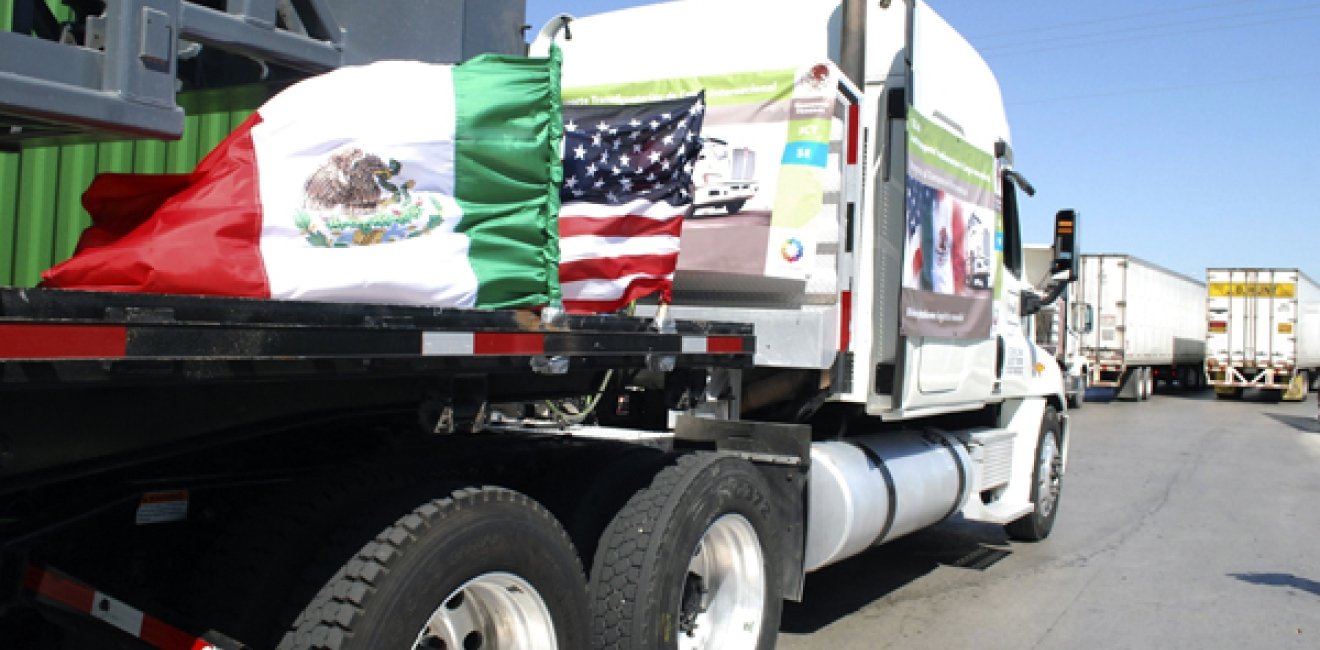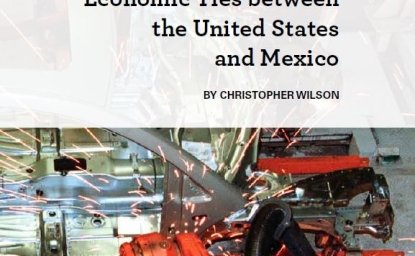Read the Final Report Here
The impact of trade and globalization on the average American has become a core issue in this year’s elections. We have heard measured, well-founded and serious critiques on the handling of issues like currency manipulation and preparing our workforce for participation in the global economy, but the conversation has also drawn many passionate and visceral responses, highlighting the intensity with which citizens feel the impact of economic change. Due to campaign rhetoric, Mexico has come to symbolize much of the U.S. encounter with globalization. Given that Mexico is the United States’ second largest export market, third largest overall trading partner, and the top country of origin for immigrants living in the country, this is understandable. Nonetheless, having become a top tier issue in the presidential elections, it is more important than ever that Americans have a clear and up-to-date understanding of Mexico and, in particular, the U.S.-Mexico economic relationship.
With that in mind, the Mexico Institute is pleased to announce the launch of a new project, Growing Together: Economic Ties between the United States and Mexico, which explores the bilateral economic relationship in detail to understand its nature and its impact on the United States. We have commissioned original research on the employment impact of bilateral trade on the U.S. economy, performed original analysis using government and academic datasets, and have undertaken an extensive review of existing research relevant to the U.S.-Mexico economic relationship. Beginning today and continuing throughout the fall of 2016, the Mexico Institute will release the findings of our research on our website and social media, using the hashtag #USMXEcon.
Our study concludes that the economic relationship with Mexico, though not without its challenges, provides concrete benefits, strengthening the competitiveness of American firms, creating jobs in the United States, and generating savings for the average American family. Key findings include:
• The United States and Mexico no longer simply sell finished products to one another. Instead, they build things together, using a regional system of manufacturing production that involves supply chains that crisscross the U.S.-Mexico border. This allows the two countries to effectively combine their individual comparative advantages into an ultra-competitive regional system, improving North America’s ability to compete on the global stage. In 2011, the most recent year for which this data is available, Mexican industries consumed $140 billion dollars in U.S. intermediate goods, and U.S. industries consumed $111 billion dollars’ worth of Mexican inputs. This is direct evidence of joint production taking place between the United States and Mexico on a massive scale.
• Nearly five million U.S. jobs depend on trade with Mexico. Our economic model shows that if trade between the United States and Mexico were halted, 4.9 million Americans would be out of work. This is a net figure and includes jobs directly and indirectly tied to trade, meaning it takes into account, 1. Jobs currently supported by the production of goods for export that would be lost if we stopped trading with Mexico; 2. Jobs that would return to the United States to produce goods we currently import; and 3. Jobs currently supported by the income individuals and companies save by having access to lower cost imports. Some of the net job gains associated with bilateral trade are in manufacturing, but the vast majority are actually in service sectors, including everything from finance to healthcare and retail. This is because the job gains associated with exports are more or less cancelled out by those lost through import competition (1 cancels out 2 in the list above), leaving the major win really coming from fact three, the availability of more competitively priced inputs for U.S. businesses and products for consumers. For example, when an American family saves $100 by buying a washing machine built in Mexico and uses that money to go to the movies, U.S.-Mexico trade is helping support the jobs of the ticket seller, movie theater manager, and maybe even Brad Pitt. The economic model we used, which is a version of the Purdue University GTAP model modified and run by The Trade Partnership, or course cannot tell us precisely what portion of Brad Pitt’s income is supported by U.S.-Mexico trade, but it can examine those types of impacts at the aggregate level across the U.S. economy.
• Without doubt, the United States is in the process of an economic transformation, and middle class workers in the United States have endured a tough period over the last couple of decades. Real median household income, though up sharply over the last year, is still below its pre-recession high in 2007 and below the previous peak in 1999.[1] Manufacturing workers have been particularly hard hit, with employment in the sector down 29 percent since 2000. Service sector employment, on the other hand, is up, which suggests the United States is going through a structural shift, largely driven by productivity improvements in manufacturing that allow more goods to be produced by fewer workers. Trade, though a much smaller driver than technology, pushes in the same direction, accelerating this structural shift toward higher-skilled service jobs. Researchers from Ball State University recently found that 87% of manufacturing job losses in the period from 2000 to 2010 were caused by productivity increases, while 13% were linked to trade. [2] These transformations are positive for the overall economy, but clearly tough on those workers that have the skills to fill the jobs of yesterday rather than the jobs of tomorrow.
• The United States has for many years administered Trade Adjustment Assistance in order to assist workers whose jobs and industries have faced increased import competition, but it is a small program with limited success. Given the size of the challenge to train and retrain the U.S. workforce so that it is prepared for the jobs of the 21st Century, a much broader, whole of government strategy is urgently needed. It is no longer sufficient to provide assistance to workers who have lost their jobs due to imports from other countries. Instead we need to face the fact that the structural shift in the U.S. economy requires an economic adjustment program, a more holistic take on smoothing the negative effects on American workers that takes into account the multiple dimensions of the transformation.
• Mexican foreign direct investment in the United States has nearly doubled since 2007, and businesses supported by Mexican investment in the United States employ more than 123,000 jobs.[3] These investments impact all fifty states and include a diverse group of industries, from construction and mining to television and financial services. Grupo Bimbo, for example, which is the world’s largest baking company and is Mexican-owned, operates over 70 bakeries and employs 27,000 people in the United States, managing well-known brands like Sara Lee and Entenmann’s. Even the U.S. auto industry, which has been the subject of much attention for recent announcements of major investments in Mexico, receives significant Mexican investment. Nemak, which supplies one-quarter of all light vehicles in the world with aluminum engine components, and Rassini, a top global producer of brakes and suspensions, run factories in Kentucky, Michigan, Ohio and Tennessee.[4]
• To be sure, there are times when firms close their factories in the U.S. and move to Mexico. However, there is strong evidence that investment by U.S. firms in Mexico is more often associated with job growth in their U.S. operations than with job losses. Theodore Moran and Lindsay Oldenski have analyzed U.S.-Mexico trade and investment data from 1990 to 2009, and find that on average a ten percent increase in employment at U.S. companies’ operations in Mexico leads to a 1.3 percent increase in the size of their workforce in the United States, a 1.7 percent increase in exports from the United States, and a 4.1 percent increase in U.S. research and development spending.[5] There is also evidence that the jobs created in the U.S. due to this phenomenon require higher skill levels, reinforcing the need for worker training and re-training to benefit from this transition and qualify for these higher-paying positions.
At the core, the question is whether the United States and Mexico are better conceived as competitors or partners. Without doubt, there are some elements of the relationship that are zero-sum, but our profound ties, ranging from cross-border supply chains to migration to cooperation to prevent terrorist attacks, mean that at the deepest level the United States and Mexico truly are partners. Millions of American workers already benefit from the relationship. With the right approach by decision-makers on both sides of the border, those benefits can be expanded and extended to millions more. The United States and Mexico depend on each other more than ever for our economic well-being and competitiveness. We will sink or swim together in the global economy.
Growing Together Final Report
Growing Together: Economic Ties between the United States and Mexico
Growing Together Working Papers
A Regional Manufacturing Platform
Cross-Border Investments Lay the Foundation for Shared Regional Prosperity
How Trade with Mexico Impacts Employment in the United States
Growing Together Factsheets & Infographics
Check back frequently. We will continue to add more resources.
Growing Together: Mexico & the United States
Growing Together: U.S. Jobs that Depend on Trade with Mexico
Growing Together: California & Mexico
Growing Together: California Factsheet
Growing Together: Louisiana & Mexico
Growing Together: Louisiana Factsheet
Growing Together: Wisconsin & Mexico
Growing Together: Wisconsin Factsheet
Growing Together: North Carolina & Mexico
Growing Together: North Carolina Factsheet
Growing Together: Ohio & Mexico
Growing Together: Ohio Factsheet
Growing Together: Michigan & Mexico
Growing Together: Michigan Factsheet
Map of U.S. States' Economic Ties to Mexico
Growing Together: Minnesota & Mexico
Growing Together: Minnesota Factsheet
Growing Together: Missouri & Mexico
Growing Together: Missouri Factsheet
Growing Together: Florida & Mexico
Growing Together: Florida Factsheet
Growing Together: Rhode Island & Mexico
Growing Together: Rhode Island Factsheet
Growing Together: Oklahoma & Mexico
Growing Together: Oklahoma Factsheet
Growing Together: Kansas & Mexico
Growing Together: Kansas Factsheet
Growing Together: Georgia & Mexico
Growing Together: Georgia Factsheet
Growing Together: North Dakota & Mexico
Growing Together: North Dakota Factsheet
Growing Together: New Jersey & Mexico
Growing Together: New Jersey Factsheet
Growing Together: New Hampshire & Mexico
Growing Together: New Hampshire Factsheet
Growing Together: Nebraska & Mexico
Growing Together: Nebraska Factsheet
Growing Together: South Dakota & Mexico
Growing Together: South Dakota Factsheet
Growing Together: Pennsylvania & Mexico
Growing Together: Pennsylvania Factsheet
Growing Together: New York & Mexico
Growing Together: New York Factsheet
Growing Together: U.S. Jobs Created by Mexican Investment
Growing Together: Arizona & Mexico
Growing Together: Arizona Factsheet
Growing Together: Mexican Companies with Operations in the United States
Growing Together: Colorado & Mexico
Growing Together: Colorado Factsheet
Growing Together: Massachusetts & Mexico
Growing Together: Massachusetts Factsheet
Growing Together: Texas & Mexico
Growing Together: Texas Factsheet
Growing Together: Indiana & Mexico
Growing Together: Indiana Factsheet
Growing Together: New Mexico & Mexico
Growing Together: New Mexico Factsheet
Growing Together: Arkansas & Mexico
Growing Together: Arkansas Factsheet
Growing Together: Iowa & Mexico
Growing Together: Iowa Factsheet
Growing Together: Tennessee & Mexico
Growing Together: Tennessee Factsheet
Growing Together: Illinois & Mexico
Growing Together: Illinois Factsheet
Growing Together: Mississippi & Mexico
Growing Together: Mississippi Factsheet
Top U.S. Cities Exporting to Mexico
Growing Together: Alaska Factsheet
Growing Together: Delaware Factsheet
Growing Together: Montana Factsheet
Growing Together: Vermont Factsheet
Growing Together: Wyoming Factsheet
Growing Together: Connecticut Factsheet
Growing Together: South Carolina Factsheet
Growing Together: Nevada Factsheet
Growing Together: Oregon Factsheet
Growing Together: Utah Factsheet
Growing Together: Virginia Factsheet
Growing Together: Washington Factsheet
Growing Together: West Virginia Factsheet
Growing Together: Maryland Factsheet
Growing Together: Maine Factsheet
Growing Together: Kentucky Factsheet
Growing Together: Idaho Factsheet
Growing Together: Hawaii Factsheet
Growing Together: Alabama Factsheet
[1] Federal Reserve Bank of St. Louis, 2016, https://fred.stlouisfed.org/series/MEHOINUSA672N.
[2] Hicks and Devaraj, 2015. The authors used worker productivity levels of the year 2000 to calculate the hypothetical number of employees needed to reach actual 2010 levels of production: the U.S. would have needed to employ around 20.9 million workers with no productivity gains but in reality only ended up employing 12.1 million.
[3] Doubled: U.S. Bureau of Economic Analysis, 2016; employment: Mexican Secretaría de Economía, using IMAP Database, 2015.
[4] Andrew Selee, “Money is flowing over the U.S.-Mexico border, but it’s going north,” Washington Post, June 1, 2016, https://www.washingtonpost.com/posteverything/wp/2016/06/01/money-is-flowing-over-the-u-s-mexico-border-but-its-going-north/?utm_term=.c044f3d177ca.
[5] Theodore H. Moran and Lindsay Oldenski, “How U.S. Investments in Mexico have increased investment and jobs at home” in NAFTA 20 Years Later, Washington, DC: Peterson Institute for International Economics, November 2014.







